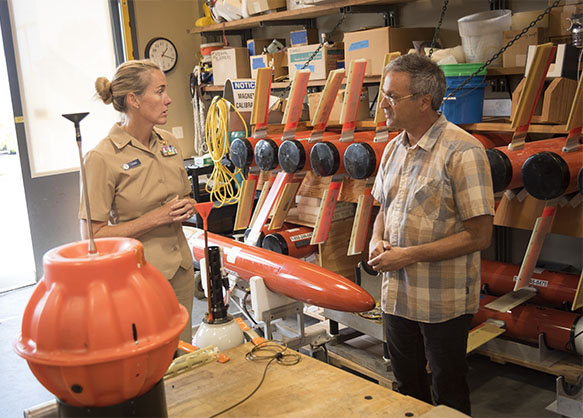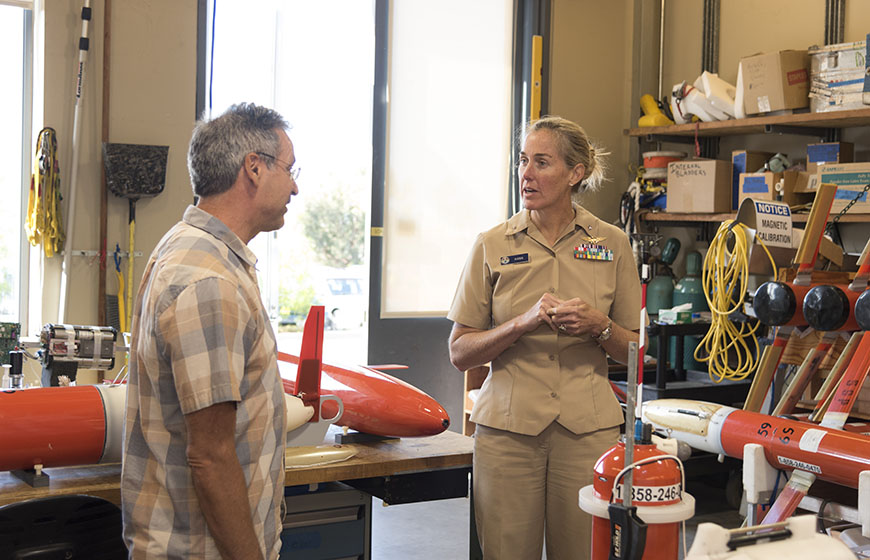
Are there any current NOAA partnerships or programs OMAO is working on that you are particularly excited about?
NH: I am excited about the diversity and breadth of our current partnerships. Our collaboration with Scripps Oceanography has been invaluable to leverage our shared assets and capabilities, test and evaluate new technologies such as the Directional Wave Spectral Drifter and expand our mission set into areas such as atmospheric river events. During my visit it was apparent there are many opportunities to expand our partnership with Scripps including support for at-sea projects and growing the future workforce. We have also developed excellent partnerships with the U.S. Navy to leverage survey, culture and training expertise.
Hurricane Hunters and Gulfstream IV aircraft are critical tools for deployment of observational technology, helping scientists better understand extreme weather events such as atmospheric rivers. How has the rise of extreme weather events affected OMAO’s funding priorities?
NH: Within NOAA’s nine aircraft, OMAO operates two Lockheed WP-3D Orion turboprop aircraft and one Gulfstream IV-SP aircraft. These aircraft collect data that directly feed extreme weather forecasts and understanding, including hurricanes, winter storms in the North Atlantic, and atmospheric rivers. The data these aircraft collect provide a tremendous value to the nation for public safety, national security and economic security. We have been well supported to ensure sustainment of these platforms and data into the future. There is currently no aircraft capable of carrying the tail Doppler radar and flying into hurricanes other than the P-3 aircraft. Our two WP-3D Orions recently completed mid-life extensions including new wings, new engines and new avionics. NOAA’s Gulfstream IV is over 25 years old. We received funding in FY 2018 to purchase a new high altitude jet and are underway with the acquisition. The disaster response imagery mission is also very important; the images collected immediately after a storm passes and posted publicly provide emergency managers, businesses and the public critical data. We also received funding in FY 2018 for an aircraft with the capability to perform this disaster response imagery mission.
How has observational technology changed since you first entered the field?
NH: It has been exciting to see the growth in technology. During my first sea tour, we were at the infancy of applying acoustic data to estimate fish stocks. That tool has expanded exponentially. I started work with unmanned aircraft systems (UAS) in 2006, launching a vehicle from shore to collect data at the air-sea interface in a hurricane. The technology has progressed to the point where we have been able to launch, command and control a test UAS vehicle from an aircraft in the eye of a hurricane. In 2011, we tested the first application of an UAS to conduct photogrammetry-based abundance and life history studies. That program has expanded to multiple applications spanning from Antarctica to the Aleutian Islands, over 1,000 flights per year, and upgraded to collect samples of whale blowhole spray. These are but a few examples that serve to better utilize our assets and answer important scientific questions.
What is your favorite part of your job?
NH: While I love our mission, the ships, aircraft and operations, I get my inspiration and motivation from our people. Every time I have the opportunity to interact with our team, I am energized to make the Office of Marine and Aviation Operations the best possible place to work with the most advanced and reliable assets. We have so many talented, passionate, committed team members and are continually looking for ways to improve our organization. Knowing that I am entrusted to lead this team to provide important at-sea and airborne data is a true honor.
What advice would you give to the next generation of earth and ocean science leaders?
NH: Keep your aperture open to where, when, and in what ways your career will blossom and you can add value. Be curious and continue learning. Ask the tough questions and keep at them until you find solutions. Look for creative solutions, and be multi-dimensional in these thoughts. Invest time in developing relationships and collaborations, they are invaluable. Your career path, contributions, and trajectory within the fields of earth and ocean science will likely be different than you envision at this moment. Embrace those opportunities and don’t forget to have fun!
– Brittany Hook






修改评论